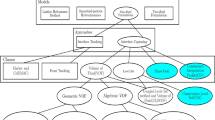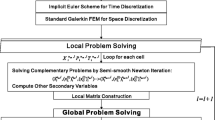Abstract
The multiphase flow simulator moving particle semi-implicit (MPS) method is developed based on the fractional-flow approach, originated in the petroleum engineering literature, considering the fully three-phase flow with general boundary conditions. The fractional flow approach employs water saturation, total liquid saturation, and total pressure as primary variables. Most existing models based upon fractional flow are limited to two-phase flow and specific boundary conditions. Although there appear a number of three-phase flow models, they were mostly developed using pressure-based approaches, which require variable-switch techniques to deal with phase appearance and disappearance. The use of fractional flow-based approaches in MPS makes it unnecessary to use variable-switching to handle the change of phase configurations because the water saturation, total liquid saturation, and total pressure exist throughout the solution domain regardless of whether certain phases are present or not. Furthermore, most existing fractional flow-based models consider only specific boundary conditions, usually Dirichlet-type pressure for water phase and flux-type boundary for nonaqueous phase liquid or particular combinations for individual phase. However, the present model considers general boundary conditions of ten most possible and plausible cases. The first eight cases are the combinations of the phase pressure or the phase flux of each of the three individual phases. The other two cases are the variable boundary conditions: one for water-medium interface and the other for the air-medium interface when the directions of fluxes are not known a priori. Thus, the model’s capabilities of handling general boundary conditions extend the simulators’ usefulness in the field system.
Similar content being viewed by others
References
Bastian, P., Helmig, R.: Efficient fully-coupled solution techniques for two-phase flow in porous media parallel multigrid solution and large scale computations. Adv. Water Resour. 23, 199–216 (1999)
Binning, P., Celia, M.A.: Practical implementation of the fractional flow approach to multi-phase flow simulation. Adv. Water Resour. 22, 461–478 (1999)
Bradford, S.A., Abriola, L.M., Rathfelder, K.M.: Flow and entrapment of dense nonaqueous phase liquids in physically and chemically heterogeneous aquifer formations. Adv. Water Resour. 21, 117–132 (1998)
Burkley, S.E., Leverett, M.C.: Mechanism of fluid displacement in sands. Trans. AIME 146, 107–116 (1942)
Carrano, C.S. Jr., Yeh, G.T.: A fourier analysis of dynamic optimization of the Petrov–Galerkin finite element method. Int. J. Numer. Methods Eng. 38, 4123–4155 (1995)
Celia, M.A., Binning, P.: Two-phase unsaturated flow: one dimensional simulation and air phase velocities. Water Resour. Res. 28, 2819–2828 (1992)
Christie, I., Griffiths, D.F., Mitchell, A.R., Zienkiewicz, O.C.: Finite element methods for second order differential equations with significant first derivatives. Int. J. Numer. Methods Eng. 10, 1389–1443 (1976)
Dekker, T.J., Abriola, L.M.: The influence of field-scale heterogeneity on the infiltration and entrapment of dense nonaqueous phase liquid in saturated formulations. J. Contam. Hydrol. 42, 187–218 (2000)
Guarnaccia, J.F., Pinder, G.F.: NAPL: a mathematical model for the study of NAPL contamination in granular soils, equation development and simulator documentation. The University of Vermont, RCGRD #95-22, (1997)
Kaluarachchi, J.J., Parker, J.C.: An efficient finite elements method for modeling multiphase flow. Water Resour. Res. 25, 43–54 (1989)
Kueper, B.H., Frind, E.O.: Two-phase flow in heterogeneous porous media, 1. Model development. Water Resour. Res. 27, 1049–1057 (1991)
Kueper, B.H., Frind, E.E.: Two-phase flow in heterogeneous porous media, 2. Model application. Water Resour. Res. 27, 1058–1070 (1991)
McWhorter, D.B., Sunada, D.K.: Exact integral solutions for two phase flow. Water Resour. Res. 26, 399–414 (1990)
Parker, J.C., Lenhard, R.J., Kuppusamy, T.: A parametric model for constitutive properties governing multiphase flow in porous media. Water Resour. Res. 23, 618–624 (1987)
Pinder, G.F., Abriola, L.M.: On the simulation of nonaqueous phase organic compounds in the subsurface. Water Resour. Res. 22, 109S–19S (1986)
Sleep, B.E., Sykes, J.F.: Modeling the transport of volatile organics in variably saturated media. Water Resour. Res. 25, 81–92 (1989)
Suk, H., Yeh, G.T.: 3D, three-phase flow simulations using the Lagrangian–Eulerian approach with adaptively zooming and peak/valley capturing scheme (LEZOOMPC). Hydrol. Eng. ASCE. 12(1), 14–32 (2007)
van der Vorst, H.A.: Bi-CGSTAB: a fast and smoothly converging variant of Bi-CG for the solution of nonsymmetric kinear systems. SIAM J. Sci. Stat. Comput. 13, 631–644 (1992)
White, M.D., Oostrom, M.: STOMP Subsurface Transport Over Multiple Phases. Theory Guide. PNL-11217. Pacific Northwest Laboratory, Richland, WA (1996)
Yeh, G.T., Cheng, H.P., Cheng, J.R., Short, T.E., Enfield, C.: An adaptive local grid refinement algorithm to solve nonlinear transport problems with moving fronts. In: Proc. XI-th Int. Conf. On Numerical Methods in Water Resources, pp. 577–584. Cancun, Mexico, 22–26 July, 1996 (1996)
Yeh, G.T., Chang, J.R., Short, T.E.: 2DFATMIC: users’ manual of a two-dimensional model of subsurface flow, fat and transport of microbes and chemicals. EPA/600/R-97-052, National Risk Management Research Laboratory, U.S. EPA, Ada, OK (1997)
Yeh, G.T.: Computational Subsurface Hydrology Fluid Flows, 277 pp. Kluwer Academic Publishers (1999)
Yeh, G.T.: Computational Subsurface Hydrology Reactions, Transport, and Fate, 318 pp. Kluwer Academic Publishers (2000)
Author information
Authors and Affiliations
Corresponding author
Rights and permissions
About this article
Cite this article
Suk, H., Yeh, GT. Multiphase flow modeling with general boundary conditions and automatic phase-configuration changes using a fractional-flow approach. Comput Geosci 12, 541–571 (2008). https://doi.org/10.1007/s10596-008-9094-x
Received:
Accepted:
Published:
Issue Date:
DOI: https://doi.org/10.1007/s10596-008-9094-x




